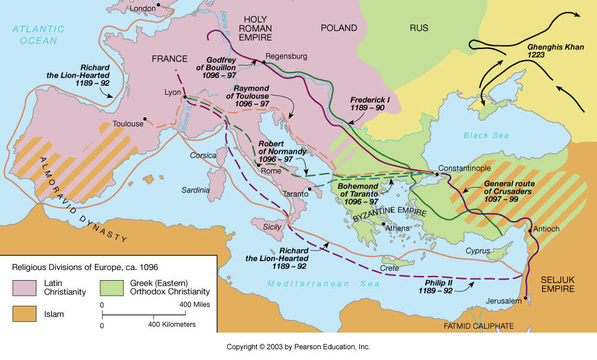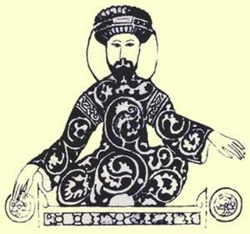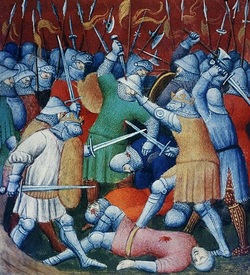The Four Major Crusades

There were four major Crusades to reclaim Jerusalem starting in about 1095.
The First Crusade began in 1095 when Arab forces took control of Jerusalem and barred Christian and Jewish people from worshiping there. The pope sent Christian Knights to take the city back, and after two years, successfully reclaimed Jerusalem for Christians.
The Second Crusade began in 1147 when, after just a short period of Christian occupation (50 years), Jerusalem was once again claimed by Muslim forces. This crusade lasted two years and was unsuccessful for the Christian warriors.
The Third Crusade began in 1189 and lasted three years. This crusade included the notable historical figures of Saladin and King Richard the Lionhearted. It was also unsuccessful for the Christian forces.
The Fourth Crusade began in 1202 and was different from the first three crusades because it was an attack on Constantinople, not Jerusalem. The Crusaders plundered the city supposedly to fund yet another crusade to regain control of Jerusalem. This crusade lasted two years and ended with bitter feelings in Constantinople towards the kingdoms of the West.
The First Crusade began in 1095 when Arab forces took control of Jerusalem and barred Christian and Jewish people from worshiping there. The pope sent Christian Knights to take the city back, and after two years, successfully reclaimed Jerusalem for Christians.
The Second Crusade began in 1147 when, after just a short period of Christian occupation (50 years), Jerusalem was once again claimed by Muslim forces. This crusade lasted two years and was unsuccessful for the Christian warriors.
The Third Crusade began in 1189 and lasted three years. This crusade included the notable historical figures of Saladin and King Richard the Lionhearted. It was also unsuccessful for the Christian forces.
The Fourth Crusade began in 1202 and was different from the first three crusades because it was an attack on Constantinople, not Jerusalem. The Crusaders plundered the city supposedly to fund yet another crusade to regain control of Jerusalem. This crusade lasted two years and ended with bitter feelings in Constantinople towards the kingdoms of the West.
The Third Crusade: up close and personal

Perhaps one of the most famous of the Crusaders was Richard the Lionhearted of England. This historic figure was the famous king featured in the Robin Hood legend, whose absence during the Third Crusade left his throne open to his evil brother Prince John to tax the poor people of Nottingham mercilessly. In addition to the famous Brit, an equally famous Muslim leader fought in this crusade. His name was Saladin.
Saladin was known as an effective, intelligent Muslim leader. In 1187, Saladin recaptured Jerusalem, which set off another Crusade, led by Richard the Lionhearted. This was known as the Third Crusade and lasted from 1189 to 1192.
The Third Crusade ended in a truce between Muslim and Christian forces. While Christians did not succeed in regaining control of Jerusalem, they did make at least a little headway. According to the truce, Jerusalem remained under Muslim control, but Saladin agreed to allow Christians to visit this most holy city.
Saladin was known as an effective, intelligent Muslim leader. In 1187, Saladin recaptured Jerusalem, which set off another Crusade, led by Richard the Lionhearted. This was known as the Third Crusade and lasted from 1189 to 1192.
The Third Crusade ended in a truce between Muslim and Christian forces. While Christians did not succeed in regaining control of Jerusalem, they did make at least a little headway. According to the truce, Jerusalem remained under Muslim control, but Saladin agreed to allow Christians to visit this most holy city.
Comparing Perspectives: Christian Crusades vs. Muslim Jihad

Although the Crusades were named by their Christian soldiers, both Christian AND Muslim forces fought for control of the holy city of Jerusalem. As a result, there are two perspectives on this series of military battles stretching over several hundred years. There were some similarities and some differences between these two perceptions of the Crusades.
One of the most important similarities between the Christian and the Muslim perspectives of the Crusades was the fact that both sides believed that they had the right to control the city of Jerusalem as a holy city of both Christianity and Islam. Because of this similarity, the soldiers on both sides believed that they were fighting for a holy cause. The Christian forces had been instructed in this train of thought by the pope himself. Because of this belief, both sides believed that they were justified in their actions, that they were battling in the name of God or Allah.
In addition to the similar train of thought held by both sides, there were also differences in their thoughts as well. While the Christian crusaders were able to learn from their Muslim enemies various skills in art, science and architecture, the Muslims felt that there was little they could learn from the Christians. These differences reflect the the advancements that were being made by the Muslim empire in many areas of the arts and sciences, while much of Europe was caught in a darker age of intellect. Another difference can be seen in the treatment of civilians by both the Christian forces and the Muslim forces. While the European knights were prone to violently kill people as they made their way to Jerusalem, in a lot of cases, the Muslim forces allowed people to keep their lives and their religion, in tact. This is illustrated by the truce penned by Saladin at the end of the Third Crusade.
Although there were cultural differences between both sides of the Crusades, one thing remained the same between them--both sides were intent on retaining control over their most holy land of Jerusalem. Christians came away in the end without the land but with new trade routes and an introduction to the Muslim Golden Age and the Muslims came away with the respect of many Crusaders.
One of the most important similarities between the Christian and the Muslim perspectives of the Crusades was the fact that both sides believed that they had the right to control the city of Jerusalem as a holy city of both Christianity and Islam. Because of this similarity, the soldiers on both sides believed that they were fighting for a holy cause. The Christian forces had been instructed in this train of thought by the pope himself. Because of this belief, both sides believed that they were justified in their actions, that they were battling in the name of God or Allah.
In addition to the similar train of thought held by both sides, there were also differences in their thoughts as well. While the Christian crusaders were able to learn from their Muslim enemies various skills in art, science and architecture, the Muslims felt that there was little they could learn from the Christians. These differences reflect the the advancements that were being made by the Muslim empire in many areas of the arts and sciences, while much of Europe was caught in a darker age of intellect. Another difference can be seen in the treatment of civilians by both the Christian forces and the Muslim forces. While the European knights were prone to violently kill people as they made their way to Jerusalem, in a lot of cases, the Muslim forces allowed people to keep their lives and their religion, in tact. This is illustrated by the truce penned by Saladin at the end of the Third Crusade.
Although there were cultural differences between both sides of the Crusades, one thing remained the same between them--both sides were intent on retaining control over their most holy land of Jerusalem. Christians came away in the end without the land but with new trade routes and an introduction to the Muslim Golden Age and the Muslims came away with the respect of many Crusaders.
